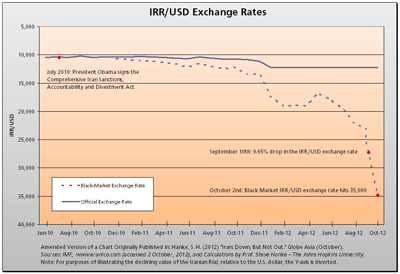The Wall Street Journal reports on the protests sweeping through Tehran:
Protests over the plunging Iranian currency erupted on Wednesday around Tehran’s main bazaar, the country’s commercial hub, as escalating economic woes become a rising political challenge.
The demonstrations marked the first time in three decades that the conservative merchant classes, a backbone of the Islamic Revolution in 1979, have publicly turned against the government.
Steve Hanke shows that the currency plunge is closely tied to the imposition of sanctions and that the extent of the plunge amounts to a new case of hyperinflation:
When President Obama signed the Comprehensive Iran Sanctions, Accountability, and Divestment Act, in July 2010, the official Iranian rial-U.S. dollar exchange rate was very close to the black-market rate. But, as the accompanying chart shows, the official and black-market rates have increasingly diverged since July 2010. This decline began to accelerate last month, when Iranians witnessed a dramatic 9.65% drop in the value of the rial, over the course of a single weekend (8-10 September 2012). The free-fall has continued since then. On 2 October 2012, the black-market exchange rate reached 35,000 IRR/USD – a rate which reflects a 65% decline in the rial, relative to the U.S. dollar.
(click to enlarge)
Move over Zimbabwe, Iran is the new poster child of hyperinflation.
Question: was this hyperinflation part of some grand plan coming out of the CIA/Defense Department/State Department? Did economists in these institutions foresee that the sanctions would eventually push the state into creating a hyperinflationary environment? Was it part of the plan?
- Bulenox: Get 45% to 91% OFF ... Use Discount Code: UNO
- Risk Our Money Not Yours | Get 50% to 90% OFF ... Use Discount Code: MMBVBKSM
Disclaimer: This page contains affiliate links. If you choose to make a purchase after clicking a link, we may receive a commission at no additional cost to you. Thank you for your support!




Leave a Reply